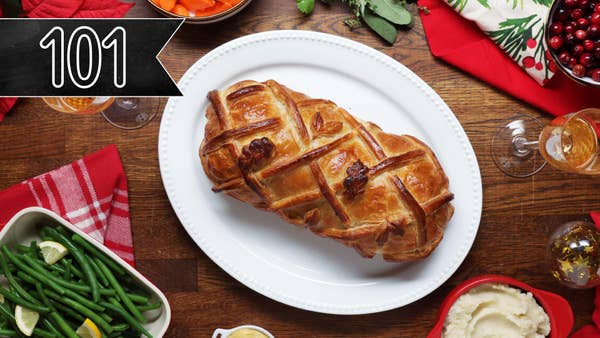Tasty 101: Beef Wellington
When it's time to impress, look no further than this centerpiece dish. This video breaksdown you everything you need to know about making the perfect beef Wellington. We even include a time-saving hack for making the mushroom duxuelles.
Tasty Team
95% would make again
Total Time
5 hr
5 hr
Prep Time
3 hr 20 min
3 hr 20 min
Cook Time
40 minutes
40 min

Total Time
5 hr
5 hr
Prep Time
3 hr 20 min
3 hr 20 min
Cook Time
40 minutes
40 min
Ingredients
for 6 servings
- 1 lb mixed mushroom (425 g), such as baby bella, shiitake, and trumpet, cleaned
- 1 beef tenderloin
- kosher salt, to taste
- freshly ground black pepper, to taste
- 2 tablespoons vegetable oil
- ¼ cup mustard (60 g)
- 2 tablespoons unsalted butter
- 2 shallots, finely diced
- 4 cloves garlic, minced
- ¼ cup cognac (60 mL)
- 12 slices prosciutto, or jamon
- all purpose flour, for dusting
- 1 sheet puff pastry, thawed, plus 1, for decorating (optional)
- 1 large egg, beaten
Nutrition Info
- Calories 410
- Fat 27g
- Carbs 24g
- Fiber 1g
- Sugar 2g
- Protein 13g
Estimated values based on one serving size.
Preparation
- Preheat the oven to 300°F (150°C).
- Add the mushrooms to the bowl of a food processor and pulse until finely diced, but not blended into a paste. Spread the mushrooms on a baking sheet in an even layer and transfer to the oven. Cook, stirring every 15 minutes, until the mushrooms have released their moisture and are dried out, about 45 minutes total.
- Meanwhile, truss the tenderloin: Measure a piece of butcher’s twine 6 times the length of the tenderloin. Wrap the twine around one end of the loin and tie a knot to secure the string. Make a loop around your hand with the string and place over the loin about 1 inch down from the first knot. Continue looping the twine in 1-inch intervals until you reach the end, then tie the twine in a knot to secure (this helps the tenderloin hold its shape). Generously season the beef tenderloin with salt and black pepper.
- Heat the vegetable oil in a large cast iron skillet over medium-high heat until shimmering. Place the seasoned tenderloin in the pan and sear quickly on all sides to lock in moisture, about 1 minute per side. Do not overcook; it’s fine if the meat does not have a golden brown crust.
- Remove the pan from the heat and transfer the seared tenderloin to a small plate or baking sheet. Cut off the twine, then brush the tenderloin with the mustard to cover completely. Transfer to the refrigerator to cool, about 1 hour.
- Return the pan to medium-low heat. Add the butter, shallots, and garlic and cook until the shallots have caramelized, about 5 minutes, stirring with a wooden spoon or heat-safe spatula to prevent from burning.
- Deglaze the pan with the cognac, stirring to scrape up any browned bits from the bottom. Continue cooking until the alcohol has evaporated and the pan is mostly dry, about 1 minute. Add the dehydrated mushrooms and stir to incorporate. Season with salt to taste. Transfer the duxelles to a bowl and cover with plastic wrap, pressing directly against the surface. Transfer to the refrigerator to cool completely, about 45 minutes.
- On a large sheet of plastic wrap, arrange the prosciutto in a large rectangle wide enough to cover the tenderloin, layering evenly. Spread the mushroom mixture evenly across the prosciutto, leaving a 1-inch border around the edges, and press down in a flat layer.
- Place the tenderloin at the bottom of the mushroom mixture and use the plastic wrap to help roll the prosciutto and mushrooms around the tenderloin. The prosciutto should tightly and completely cover the tenderloin. Hold the ends of the plastic wrap and roll the log to help create a tight seal. Refrigerate the roll until chilled all the way through, about 1 hour.
- Place a sheet of puff pastry on a lightly floured surface and roll out with a lightly floured rolling pin until the pastry sheet is large enough to cover the log.
- Brush the top third of the puff pastry with beaten egg. Unwrap the log and place on the bottom third of the pastry, then roll up into a tight log, turning so the seal is at the bottom. Fold in the sides of the pastry and press under the log. Set the log on a large sheet of plastic wrap and roll to wrap tightly. Refrigerate again while the oven preheats.
- Preheat the oven to 425°F (220°C). Line a baking sheet with parchment paper.
- Unwrap the log and set on the prepared baking sheet. Brush the log all over with beaten egg, then use a paring knife to create a decorative pattern on the puff pastry. Alternatively, cut the second sheet of puff pastry into long strips and create a lattice over the Wellington, and/or cut out autumnal shapes and press them onto the log. Brush the log with more beaten egg.
- Bake the Wellington until the puff pastry is a deep golden brown, 30–40 minutes. If the pastry is getting too dark before the beef is finished cooking, cover loosely with foil and continue cooking. The internal temperature of the beef should reach 125°F (52°C) for a medium-rare finish.
- Remove the Wellington from the oven and let rest for 1 hour. The internal temperature will continue to rise to 135°F (57°C).
- Slice the beef Wellington into 1-inch pieces and serve.
- Enjoy!
- Your favorite recipes are just a click away. Download the Tasty app to save and organize your favorites.
